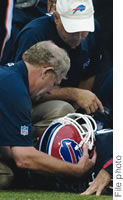After A Spinal Cord Injury
Interviewed by Guest Writer
Wednesday - September 19, 2007
E-mail this story | Print this page | Comments (0) | Archive
 Del.icio.us Share
Del.icio.us Share

|
Spinal-cord injury is in the spotlight since NFL player Kevin Everett suffered a game-time injury last week. Judging from the nature of his neck injury - compression of the C3 and C4 vertebrae - how will this affect him?
Even though his recovery looks promising, this level of injury puts him at risk for breathing problems, pneumonia, blood clots as well as other complications associated with spinal-cord injuries.
Everett’s outlook, though, improved after an initial bleak assessment. Is this common?
When the initial injury happens there’s a lot of swelling and trauma that’s associated with that. Once that starts to heal, then people do get better.
Some doctors attribute his improvement to an experimental cooling technique. What can you tell us about that procedure?
What I’ve been reading is it is still experimental, and there are only certain centers that are testing it. And it sounds like it hasn’t been used a lot in spinal-cord injuries yet. I haven’t seen the research on it so it’s hard to say how much of his recovery can be attributed to that as opposed to all of the other excellent medical attention he received.
In Hawaii, spinal-cord injury is often associated with activities like body surfing at Sandy Beach. What are the most common causes of spinal-cord injury here?
The big things here are ocean-related activities like body surfing, surfing or diving into shallow water. The other big thing is car/motorcycle accidents. It’s probably split half and half between sports and motor vehicle collisions.
Does spinal-cord injury most often happen to young, healthy men and boys?
Our biggest demographic is men between the ages of 18 and 35. They’re usually young, otherwise healthy and they’re the ones who participate in the highest-risk activities.
After an injury, where does Rehabilitation Hospital of the Pacific come in?
Once they are medically stabilized at the acute hospital, they then come to Rehab Hospital. The usual stay here is about four weeks and we use physical and occupational therapy to improve their strength and functional mobility.
What’s more common after spinal-cord injury, paraplegia (paralysis of both legs) or quadriplegia (paralysis of both arms and both legs)?
Here in Hawaii, I’ve seen a lot of quadriplegia and most of them are “incomplete injuries,” which means that patients do have some recovery of feeling and motor strength. We’re able to work with that and use adaptive equipment and techniques to get people back to work, driving, into the ocean, playing sports, and doing all these things even though they’re not able to walk anymore.
So there’s life after quadriplegia?
Definitely. What Rehab does is teach them how they’re going to go back and live the same life they did before - they’re just going to be doing things a little differently. That’s where adaptive technology and equipment come into play. They can work, drive, play sports, get married, have a family. They can do everything they did before their injury and even tackle some new challenges.
How much independence do they gain back, or will they always be at least partially dependent on someone?
It depends on the level of quad-riplegia, but most can be independent. ... Paraplegics can be completely independent.
Describe a success story.
One of my patients who’s kind of a local fishing legend here in Hawaii, he’s a paraplegic. He was referred to me by his doctor and ... now he’s able to surf with his daughter and enjoy the beach again with his family after 30 years of thinking he wasn’t able to do that anymore. Just giving that hope back to someone through what we do at the Rehab Hospital is really rewarding.
What types of auxiliary programs does Rehab Hospital offer?
Our adaptive sports program here is called Beyond the Limit and includes surfing, paddling, basketball and tennis programs. Anyone who has a spinal-cord injury is welcome to attend. (E-mail recreational therapist Catherine Church at .(JavaScript must be enabled to view this email address).)
Some of our athletes are going to be surfing next year through the Challenged Athletes Foundation, and they’ll be traveling to different competitions around the country. We give people the opportunity to break down perceived barriers or limits. That’s the goal of the program.
Anything else?
We also have a monthly support group that meets here and provides information on resources available to people with spinal-cord injuries.
(For more programs information, call Dr. Somal at 566-3460, or visit www.rehabhospital.org)
E-mail this story | Print this page | Comments (0) | Archive
Most Recent Comment(s):













